Weighted blankets are an amazing way to help you relax, unwind and sleep amazing. But using your weighted blankets day after day will inevitably require it to get washed from time to time. We’re going to share exactly how to wash a weighted blanket so you can get back using and loving your favorite blanket in no time without the worry of damaging your blanket or your washing machine!
Weighted blankets have become super popular over the past few years. With the many benefits of things that they can help with anxiety, ADHD or trouble sleeping, I can see why! I’ve owned a weighted blanket for a while now and I love using it at night after a busy day of chasing toddlers around. It quickly helps me unwind and relax.
There are tons of weighted blanket companies out there who make a variety of different types of weighted blankets in all different sizes and weights. This guide will cover how to wash most weighed blankets but it’s always very important to check the care instructions on your weighted blanket to make sure you can put it in the washing machine!
How to Wash a Weighted Blanket
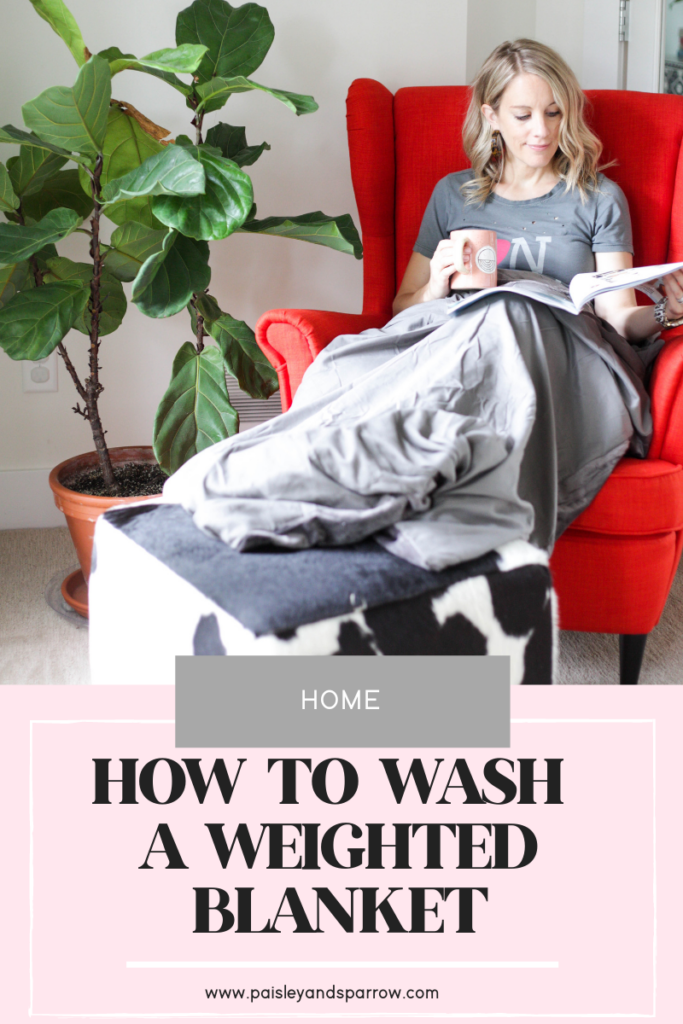
We’ll go through a few different ways to wash your weighted blanket depending on the type of blanket that you have
Washing a Weighted Blanket with a Cover
1. Check the Care Instructions
The very first thing you’ll want to do is check the care instructions. Most weighted blankets can be washed in the washing machine, but some have outer covers made out of fabrics that shouldn’t go in the washing machine. Always check the care label!
2. Remove the Cover and Wash
If your weighted blanket has a removable cover, you’re in luck! This makes your job that much easier. You’ll just need to remove the cover and wash it in cold (steer clear of hot!) on the gentle cycle with like colors. Use a non-chlorine bleach gentle detergent. After it’s washed, simply tumble dry.
3. Spot Clean the Weighted Core
If your weighted blanket has a cover, then you’ll just need to spot clean the inner blanket aka the weighted core. The easiest way to do that is use a toothbrush dipped in a solution of laundry detergent and warm water. Gently scrub the spots that need a little love and rinse clean.
Side note: if you’re weighted blanket doesn’t have a cover, we highly recommend getting one! Picking up a removable duvet cover will make cleaning your weighted blanket a whole lot easier and a way less stressful!
No Cover? Machine Wash Your Weighted Blanket
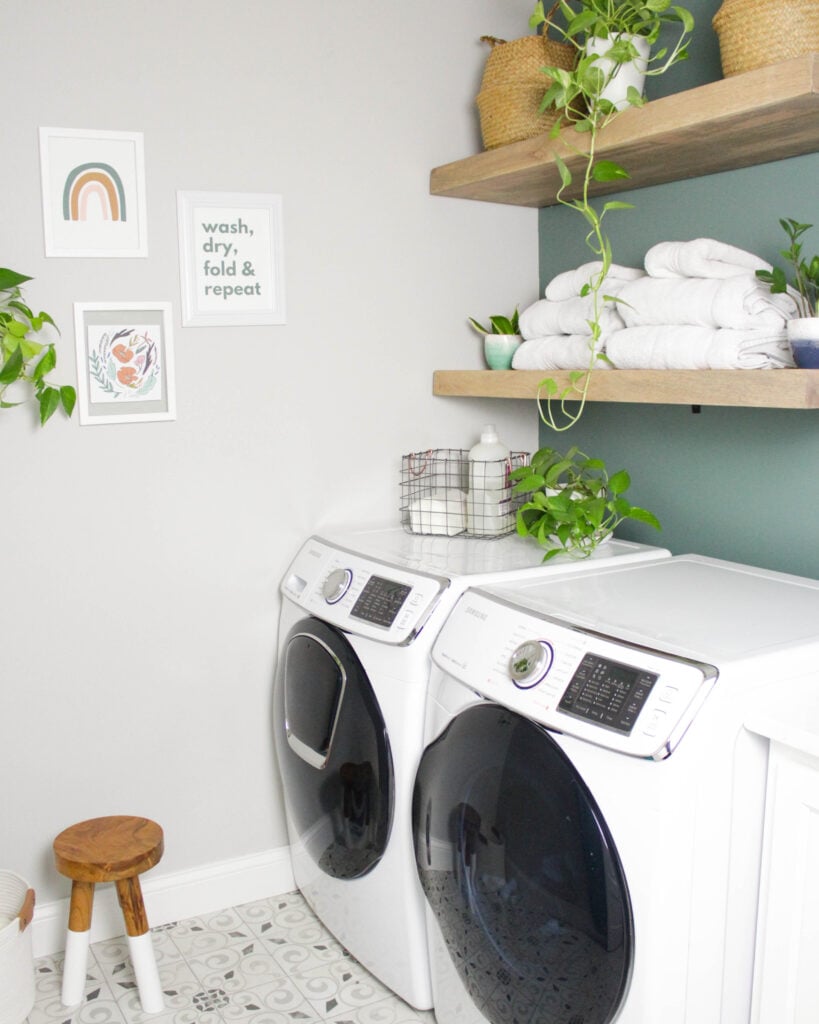
Machine washing your blanket can be a scary and intimidating thing. These step by step instructions will hopefully help take away some of the fear when you wash your blanket in your home washer!
1. Check the Care Instructions
Like the number one instruction for washing with the cover, the very first thing you’ll want to do is check the care tag. Most weighted blankets can be washed in the washing machine always check the label for specific washing instructions!
2. Check the Weight
The next important thing to do is double check the weight of your blanket. In most cases, if your weighted blanket weighs less than 20 pounds than you can safely wash your blanket at home. It’s probably a great idea to double check your specific washing machine to see how much a load it can handle. Usually around 20 pounds is ok for most washing machines but heavier blankets should be not washed at home.
If It’s over 20 pounds, you’ll want to bring it in to a laundromat and use one of their specially made commercial-sized machines, so you don’t break yours!
Again, double check the care instructions on the tag to make sure that your specific blanket can be put in the wash. If it can, put it in the washing machine and wash on the gentle cycle using cold water and a mild detergent. Do not use fabric softener or it can become
3. Dry Your Blanket
After you’ve put your entire blanket in the wash, it’s time for the drying process. Most blankets can be put in the dryer (again, check the care tag to make sure your specific blanket is dryer safe). In most cases, though, the pellets and glass beads can be easily put in the dryer without melting them.
If you do use the dryer, be sure to use the low heat cycle and stay away from high temperatures. The pellets and glass beads won’t hold any water so it should actually dry fairly quickly.
To keep your blanket in tip top shape, air drying it is the best option! Obviously, this is the option that will take the longest, but it will help keep your blankets lasting a long time.
You’ll want to lay out your blanket evenly so it doesn’t lose its shape or stress the seams.
How to Hand Wash Your Weighted Blanket

If you’re nervous about washing your weighted blanket in the washing machine or don’t have access to a front loading one, no problem! Hand washing is always an option. Here’s what you’ll do.
1. Fill Bathtub
Fill your bathtub roughly half full (depending on the size of your bathtub) with cold water and add ½ cup of mild detergent. Add the detergent while the water is filling the tub to ensure it’s mixed well in the water.
2. Put Blanket in Tub
Put blanket in the soapy water making sure it’s fully submerged.
3. Scrub Blanket
Scrub your blanket well focusing on soiled or stained spots. Make sure you get the entire blanket cleaned.
4. Drain Tub
Leaving the blanket in the bathtub, drain all the water out. Squeeze out excess out, not worrying too much about getting it fully squeezed out.
5. Fill Tub Again
Fill up your tub again with cold water, covering the blanket. Agitate the blanket to rinse out soap that is left in the blanket.
6. Drain Water
Again, drain out the water and squeeze out excess water from the blanket.
7. Repeat Rinse Cycle
Repeat the rinse, agitate and drain cycle as much as needed to rinse the blanket of all soap.
8. Remove Excess Water
Fold your blanket in half (or in 4ths depending on the size of your blanket). Roll the blanket up starting one side. Unroll and move to the other side, rolling it up again. Keep rolling and unrolling until most of the water is gone.
9. Hang to Dry
Your best option is to put it outside to dry. Lay it out flat in the sun (you’ll likely want to lay down another blanket or towels to protect it from the dirty ground) and flip it over every hour or so until it’s dry.
If you don’t have the option of laying it outside to dry, you can always dry it indoors. Lay it out flat on a drying rack if possible or hang it evenly over a very sturdy curtain rod.
Things to Avoid When Washing Your Weighted Blanket
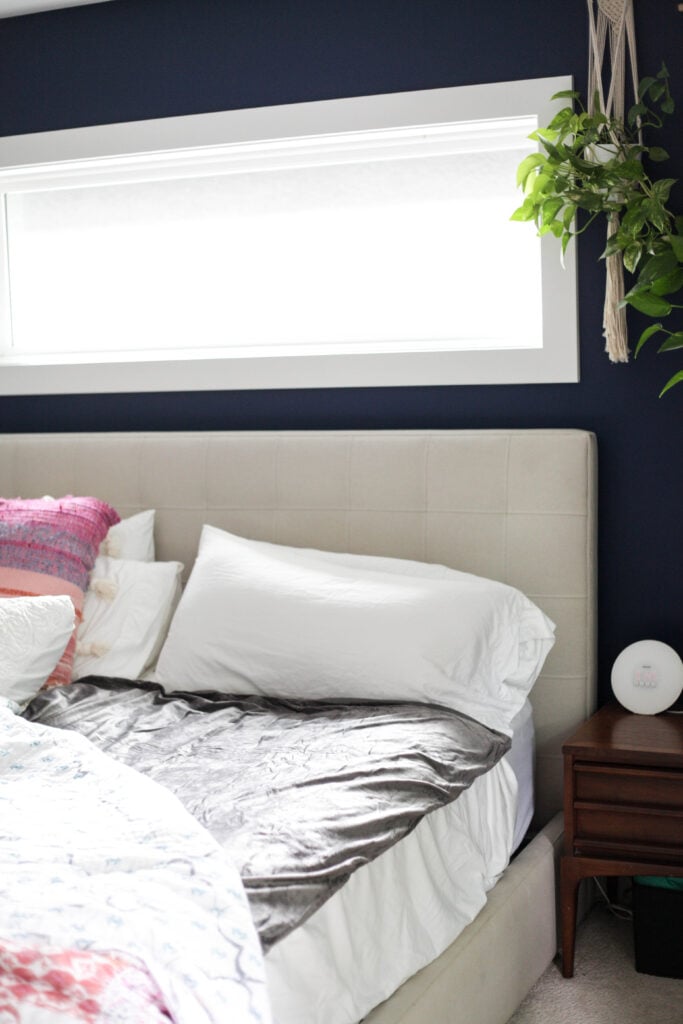
Don’t dry clean
Unless you have a blanket made out of fabric specific for dry cleaning, you’ll always want to wash your blanket at home. Wool, rayon or linen fabrics are typically dry cleaned – if your blanket is made out of one of these you can potentially look into bringing it in to a dry cleaner.
Don’t use hot water
When you wash your weighted blanket you never want to use hot water. Most blankets are made out of minky, cotton and rayon-linen blends and all of these should be washed on cold water. Fleece or flannel fabrics can be washed on cold or warm depending on the soil level and type of fill.
Don’t use high heat
Like using hot water, high heat could shrink your fabric or cause damage to your blanket. Keep your heat low.
Stay away from harsh chemicals or bleach.
Using harsh chemicals or bleach will wear out the fabric of your blanket which will shorten the lifespan of it. Especially if this is a splurge item for you, you want to use gentle detergents so you’ll have your blanket for a long time.
Don’t iron your blanket
I know that some of you hate the look of any fabric that’s wrinkled but it’s not advised to iron your blanket. If you have a removable cover, you can easily remove the cover to iron that separately but don’t iron the blanket itself.
Never use fabric softeners on the weighted core
If your blanket’s outer cover is a fabric that can handle fabric softener you can use that when washing. However, if you’re washing your entire blanket in the washing machine, don’t use fabric softener.
Don’t over wash your blanket
Just like your clothes, the more you wash your weighted blanket the more wear and tear it will experience. Only wash your blanket when you need to and spot clean in between washings.
Which Type of Weighted Blanket Fillers are Machine Washable
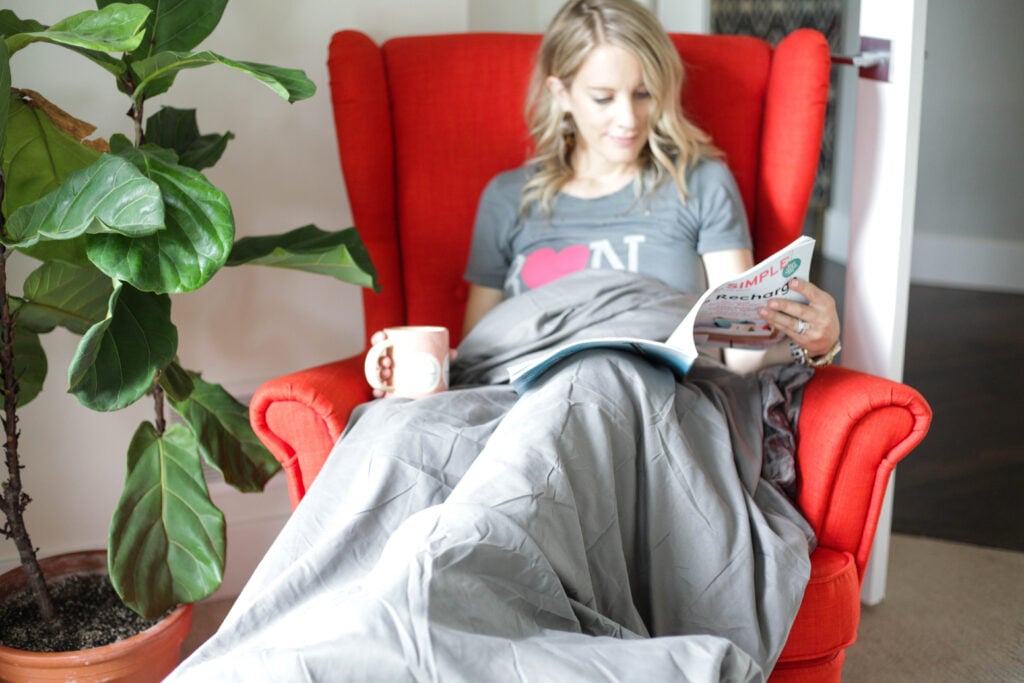
Not all fillers are created equally! Here’s some of the main types of fillers and whether they can go in the washing machine or not.
Micro Glass Beads
Micro glass beads are your best option when choosing a weighted blanket. Not only are glass beads tiny and noiseless but there’s no chance of them melting when you put it in the dryer! Water also won’t soak into them making washing and drying much quicker and easier.
Steel Beads
Steel shot beads are another popular option for weighted blankets since they’re made out of steel (as their name implies) making them a great heavy weight that isn’t super bulky. The one issue with these are, you shouldn’t put them in the washing machine. Since the steel beads are incredibly heavy you run the risk of the blanket seams ripping causing tiny beads to fill your machine. Not worth the risk!
Plastic Poly Pellets
You’ll also see blankets using plastic poly pellets that are typically made from ABS virgin plastic. These plastic beads are great because they haven’t been exposed to any chemicals or toxins however, washing them on higher temps could cause the plastic pellets to melt and clump together. Keep these out of the washing machine!
Rice/Beans/Natural or Organic Material
If you see a “weighted blanket” marketing that their blanket is made out of corn, rice, etc. first know that this isn’t technically a weighted blanket. While things like rice packs make wonderful heating pads, using organic materials such as rice isn’t a great option for a weighted blanket. And if you do get one of these, please don’t put it in the washing machine!
Sand/Pebbles
Many DIYers out there love to be creative in things that they create. We’ve seen quite a few versions of weighted blankets made out of sand or small pebbles. While yes, this is a creative way to make your own weighted blanket, we advise that you just spend a few extra dollars and buy the real thing.
The last thing you want is a lose seam on your blanket filled with sand filling up your bed! And if you do make one of these, don’t put them in your washing machine.
Types of Fabric for Heavy Blankets
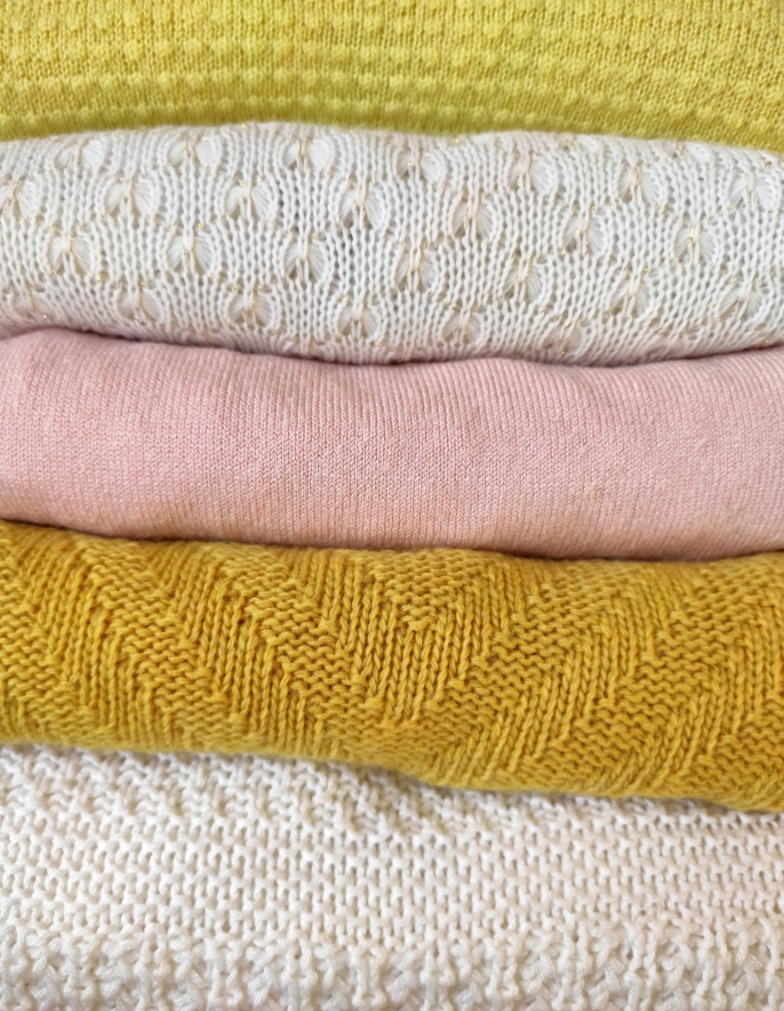
Like fill types, there are a variety of different fabrics for your weighted blanket. Like mentioned above, the type of fabric will determine how (or if) you wash your blanket. Here are some of the most common types of fabric that we’ve seen.
Cotton
The majority of the time weighted blankets are made out of 100% cotton. Cotton is a very easy to care for fabric (as I’m sure you’re aware). You can easily machine wash it just steer clear from hot water so it doesn’t shrink.
Flannel
Another type of cotton is flannel. Flannel is super soft and cozy making it a great option for weighted blankets. You’ll want to only wash flannel blankets in cold and warm so it doesn’t shrink as well.
Minky
There’s a lot of weighted blankets made out of minky fabric. Minky is another easy to care for fabric that’s incredibly soft. If you have a minky blanket be sure to wash it separate so it doesn’t get ruined or cause unnecessary wear and tear by other fabrics in your washing machine. Never use fabric softener with this type of fabric.
Wool
Wool is a very delicate fabric and should always be hand washed and never dried in the dryer. Every so often you’ll find a woold that’s able to withstand a machine wash so check the tag to see if that’s the case. If it is, be sure to wash it on your hand wash or wool cycle and use a detergent safe for wool.
Overall, there’s a lot of different variables when it comes to washing your weighted blanket. The good news is, after you find out the type of filler your blanket is, the type of fabric it is and whether or not it has an outer cover, it’s fairly simple to do!
As a reminder, we highly recommend getting a duvet cover for your blanket if it doesn’t come with them. You’ll have the best results with cleaning and keeping it in good shape if you can simply remove the cover anytime you have a coffee stain from your morning coffee or any other accident! And the best news is, you can switch up your cover anytime you want.
We hope this helps you easily wash your favorite blanket!
